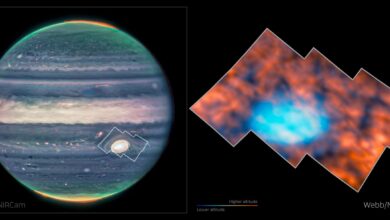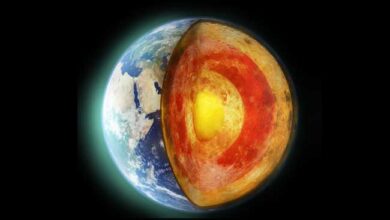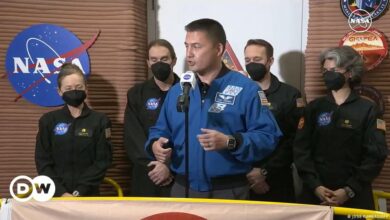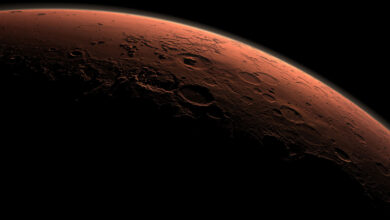Asteroid 2024 MK to pass by Earth on Saturday: What to know

[ad_1]
(The Hill) — An asteroid the size of a football stadium threaded the needle between Earth and the moon Saturday morning — the second of two astronomical near misses in three days.
Near miss, in this case, is a relative term: Saturday’s asteroid, 2024 MK, came within 180,000 miles of Earth. On Thursday, meanwhile, asteroid 2011 UL21 flew within 4 million miles.
But the Saturday passage of 2024 MK — which scientists discovered only two weeks ago — coincides with a sobering reminder of threats from space.
Sunday is Asteroid Day, the anniversary of the 1908 explosion of a rock from space above a Russian town — the sort of danger that, astronomers warn, is always lurking as the Earth hurtles through space.
Here’s what you need to know about asteroids, the risk from space and Saturday’s fly-by near miss.
What is an asteroid?
Asteroids are rocks in space that orbit the sun, rather like the planets with which they occasionally cross paths.
Also like planets, asteroids formed more than 4.6 billion years ago out of the condensing cloud of dust and gas that formed the solar system — making them in effect time capsules of the distant time before the formation of Earth or the sun.
Scientists have identified about 1.3 million of them, mostly orbiting in the vast space between Mars and Jupiter. Both individually and in the aggregate, they tend to be small — the entire weight of all the asteroids in the solar system is believed to be lower than that of the moon.
Over the long sweep of history, asteroid impacts also may have been crucial to life on Earth.
In another piece of asteroid news last week, scientists on Wednesday announced the results of a 2023 mission to the asteroid Bennu that had returned with samples, suggesting the possibility that it was full of the ingredients for water.
These findings suggested an upside to asteroid impacts. “Asteroids such as this may have played a key role in delivering water and the building blocks of life to Earth,” coauthor Nick Timms of Curtin University said.
What happens if one hits the Earth now?
An asteroid doesn’t have to be particularly large to do damage. In 2013, for instance, an asteroid about 62 feet across that broke apart nearly 20 miles above Siberia released 30 times as much energy as the atomic bomb that hit Hiroshima.
While most of the impact energy was absorbed by the atmosphere, the detonation triggered a shock wave that blew out windows and injured more than a thousand people.
Asteroid Day on Sunday commemorates an even bigger impact, the 1908 Tunguska event, which also took place above Siberia.
In that event, the Russian newspaper Sibir (Siberia) reported that peasants looking upward saw a “strangely bright (impossible to look at) bluish-white heavenly body, which for 10 minutes moved downwards.”
The body appeared to be a “pipe” cylinder, which began to “smudge” as it hit the denser atmosphere above the forest and broke apart into billowing black smoke,” the article said.
“A loud knocking (not thunder) was heard as if large stones were falling, or artillery was fired. All buildings shook. At the same time the cloud began emitting flames of uncertain shapes. All villagers were stricken with panic and took to the streets, women cried, thinking it was the end of the world.”
If 2024 MK, with a diameter of 500 to 800 feet, were to hit rather than pass by Earth on Saturday, it wouldn’t be the end of the world — at least, not quite. Such an impact would “have the equivalent impact energy in the hundreds of megaton approaching a gigaton,” Peter Brown of Canada’s Western University told the Canadian Broadcasting Service.
That’s an enormous potential impact — for context, the explosion would be 10-20 times bigger than that from most hydrogen bombs that have been tested, which are in the 50-megaton range.
“It’s the sort of thing that if it hit the east coast of the U.S., you would have catastrophic effects over most of the eastern seaboard. But it’s not big enough to affect the whole world,” Brown said.
The impact of a hypothetical collision with 2011 UL21, the asteroid that flew by Thursday, would be far more disastrous. While it was comfortably far out in space and had no chance of hitting the Earth, it was also very large: the approximate size of Mount Everest.
At 1.5 miles in diameter, that asteroid was about a quarter the size of the asteroid that struck the earth 65 million years ago, wiping out all dinosaurs that walked, as well as the majority of life on earth.
How high is the risk of a collision?
Research suggests it’s very, very low. NASA has estimated that a civilization-ending event (like the collision of an asteroid the size of Thursday’s with the Earth) should only happen every few million years.
And such an impact from an asteroid half a mile in diameter or bigger will be almost impossible for a very long time, according to findings published last year in The Astronomical Journal.
“It’s good news,” study leader Oscar Fuentes-Muñoz of the University of Colorado Boulder told the MIT Technology Review. “As far as we know, there’s no impact in the next 1,000 years.”
NASA’s catalog of large and dangerous objects like 2011 UL21 is now 95 percent complete, the Technology Review reported.
But as the 1908 and 2013 explosions suggested, a relatively small asteroid can still “cause a lot of damage,” Áine O’Brien of the University of Glasgow cautioned the Technology Review.
The map of asteroids the size of the one passing between the Earth and Moon on Saturday — which could destroy a city if it struck the planet — is still just 40 percent complete, the magazine reported, according to Big Think.
How do scientists detect and track asteroids?
They do so by continually scanning the sky, looking for relatively small, fast-moving objects. The Asteroid Terrestrial-impact Last Alert System that detected 2024 MK is one of the many surveys looking for risks.
These surveys offer early warnings that could help prevent asteroid impacts, Alan Fitzsimmons of Queen’s University Northern Ireland told the CBC.
“It’s the only natural disaster that we can stop. You can’t stop a tsunami, you can’t stop an earthquake, you can’t stop a volcano,” he said. “You can actually stop or prevent an asteroid impact, at least in theory.”
NASA managed to knock an asteroid off its course in 2022, when its Double Asteroid Redirection Test (DART) slammed a satellite the approximate weight of a small car into Dimorphos, a rock about the same size as 2024 MK — altering its orbit slightly.
The DART mission, which required NASA to execute a precise collision 7 million miles away, showed “that NASA is trying to be ready for whatever the universe throws at us,” agency Administrator Bill Nelson said during a briefing at the time.
But there’s an old saying in science that while in theory there’s no difference between theory and practice, in practice there is. Pulling off a feat like the DART mission to stop an asteroid from hitting Earth “is certainly possible, but would be a difficult and expensive task,” astronomer Alistair Gunn of the University of Manchester wrote for the British Broadcasting Corporation.
“The key would be in deflecting the asteroid away from its collision course with Earth rather than shattering it into equally dangerous debris,” Gunn added.
He also noted pulling that off would take a lead time of at least five years — which is why early warning is “vitally important.”
That need for early warning is one reason the passage of 2024 MK is so disquieting: Scientists discovered it just this month.
Earlier this week, NASA announced plans to deflect an asteroid still had “high level gaps,” USA Today reported.
“We’re using the capabilities that we have to really try to hopefully retire that hazard, to understand what’s out there, and know if anything poses a threat,” Kelly Fast, NASA’s acting planetary defense officer, told the outlet.
Were Americans be able to see Saturday’s asteroid?
Yes — if they were in the right region and are both very prepared and lucky.
Americans in the U.S. Southwest — or Hawaii — who were from light pollution and willing to rise in the predawn hours may have a shot at seeing 2024 MK as a rapidly moving dot, which will come closest to the Earth at about 9:46 Eastern time.
That’s 90 minutes before dawn in Hawaii and about an hour after dawn on the West Coast — though the asteroid will be dimly visible before it makes the passage.
For everyone outside those areas, the Virtual Telescope Project is livestreamed the passage.
Even those who are in the right region may find viewing the passage challenging, Fitzsimmons of Queen’s University told CBC. Skywatchers will need a telescope, and be prepared to spot a faint, fast-moving object. “You’ve got to know exactly where to look,” he said. “It’s motoring.”
[ad_2]
Source link




